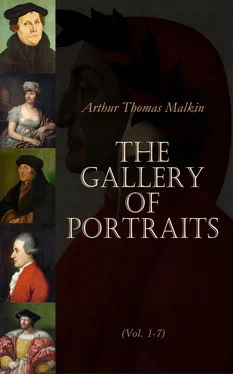As in the course of about fifteen years he produced more than double that number of dramatic pieces, instead of giving, within our narrow limits, a mere dry catalogue of titles, we shall make some more detailed remarks on a few of those masterpieces, in different styles, which not only raised the character of French comedy to a great height in France itself, but in a great measure furnished the staple to some of our own most distinguished writers.
Among many persons of taste and judgment, the Misantrope has borne the character of being the most finished of all Moliere’s pieces; of combining the most powerful efforts of united genius and art. The subject is single, and the unities are exactly observed. The principal person of the drama is strongly conceived, and brought out with the boldest strokes of the master’s pencil: it is throughout uniform, and in strict keeping. The subordinate persons are equally well drawn, and fitted for their business in the scene, so as to throw an artist-like light upon the chief figure. The scenes and incidents are so contrived and conducted as to diversify the main character, and set it in various points of view. The sentiments are strong and nervous as well as proper; and the good sense with which the piece is fraught, proves that the bustle and dissipation of the court and the theatre had not obliterated the lessons of the college, or the lectures of Gassendi. The title of the play will at once bring to the mind of an Englishman our own Timon of Athens; but there are scarcely any other points of resemblance. The ancient and the modern Man-hater had little in common: the Athenian was the victim of personal ill-treatment; having suffered by excess of good-nature and credulity, he runs into the other extreme of suspicion and revenge. Moliere’s Man-hater owes his character to the severity of virtue, which can give no quarter to the vices of mankind; to that sincerity which disdains indiscriminate complaisance, and the prostitution of the language of friendship to the flattery of fools and knaves. Wycherley, in his Plain Dealer, has given the French Misantrope an English dress. Manly is a character of humour, speaking and acting from a peculiar bias of temper and inclination; but the coarseness of the plain dealing is not to be tolerated, and what Manly does goes near to counteract the moral effect of what he says .
By way of contrasting the various talents of the author, than whom none better understood human nature in its various ramifications, or copied more skilfully every shade and gradation of manners, we may just mention the Bourgeois Gentilhomme, exhibiting the folly and affectation of a cit turned man of fashion. If the moral of the Misantrope be pure, the wit of the Bourgeois is terse and diverting.
In several of his comedies he has treated medicine and its professors not only with freedom but severity; it was, however, perverted medicine only, and its quack professors that were the subjects of his ridicule. The respectable members of the faculty could be no more affected by the satire, nor displeased by what they could not fear, than a true prophet by the punishment of imposture. Those who are acquainted with the history of the science will recollect the state of it at Paris in Moliere’s time, and the character of the physicians. Their whole employment was confined to searching after visionary specifics, and experimental trickery in chemistry. The cause of a disease was never inquired after, nor the symptoms regarded; but hypothetical jargon and random prescription were thrown like dust into the eyes of the patient, to the exclusion of a practice founded on science and observation. Thus medicine became a pest instead of a remedy; and this state of things justified the chastisement inflicted.
Les Précieuses Ridicules is a comedy intended to reprove a vain, fantastical, and preposterous humour prevailing very much about that time in France. It had the desired effect, and conduced materially towards rooting out a taste in manners so unreasonable and ridiculous.
Tartuffe, or The Impostor, has occasionally, and even recently, sometimes to the disturbance of the public peace in France, given great offence not only to those who felt the justice, and winced under the severity of the satire; but to others, who suspected that a blow was aimed at religion, under the mask of an attack upon hypocrisy. But its intrinsic merit, the truth of the drawing, and the justness of the colouring, have secured patrons for it among persons of unquestionable sense, virtue, learning, and taste; and it has always triumphed over the violence of opposition. Cibber, a vamper of other men’s plays, has borrowed from it his favourite Nonjuror, and applied it to the purposes of a political party. On this adaptation has been grafted a more modern attack on the Methodists, under the title of The Hypocrite. But however great may be the merit of this celebrated drama, it cannot boast of entire originality. Machiavelli left behind him three comedies, the fruits of a statesman’s leisure hours. In all three, the author has exhibited the hand of a master; he has painted mankind in the spirit of truth, and unmasked falsehood and hypocrisy in a tone of profound contempt. Two monks, a brother Timothy and a brother Alberico, are represented with too much wit and keenness of sarcasm to have been overlooked by Moliere in his working up of the third specimen. The first three acts of the Tartuffe were played for the first time at court before the piece was finished. Masques of pomp, magnificence and panegyric, such as usually furnish out the amusement of royal saloons, are forgotten as soon as they have served the purpose of the moment: but masterpieces like that now in question perpetuate their own renown, and leave a lasting memorial of what is supposed to be a phenomenon, a princely taste for genuine wit.
Les Fâcheux was the first piece in which dancing was so connected with the dramatic action, as to fill up the intervals without breaking the thread of the story.
Le Mariage Forcé was borrowed from Rabelais, to whom both Moliere and La Fontaine were deeply indebted. The Aristotelian and Pyrrhonian philosophy, as travestied by modern doctors, furnishes occasion for lively satire and clever buffoonery. The horror with which Pancrace calls down the vengeance of heaven on him who should dare to say the form of a hat, instead of the figure of a hat, is a pleasant parody on the unintelligible absurdities of the schools. According to Marphurius, philosophy commands us to suspend our judgment, and to speak of every thing with uncertainty; not to say I am come , but, I think that I am come .
La Princesse d’Elide, though not one of Moliere’s happiest efforts, deserves notice on account of its contributing to the festivities of the court, by an adaptation of ingenious allegories to the manners and events of the time. This satire was aimed at the illusion of Judicial Astrology, after which many princes of the period were running mad; and in particular Victor Amadeus, Duke of Savoy, father of the Duchess of Burgundy, who kept an astrologer about his person even after his abdication. The dramatic antiquary may find some amusement in comparing the fêtes of the French court with the masques of Ben Jonson, Davenant, and others, exhibited before our James I. and Charles I.; but here the interest ends. It is sufficient to remark, that the masques of the English court owed their power of pleasing to the ingenuity of the machinist and the flattery of the poet. The little dramas performed before the royal family of France tickled the ears of the audience by the pungency of their wit and ridicule.
The Miser has been pretty closely translated, for the version is little more, by Henry Fielding; but not so happily as he himself seems to have imagined.
Читать дальше












